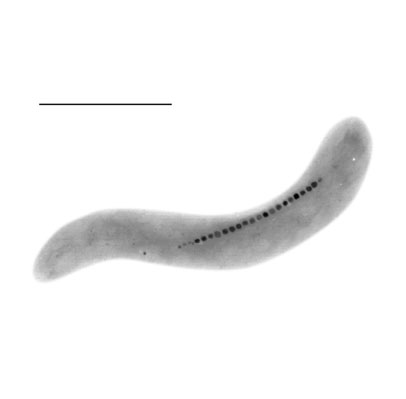Team:BCCS-Bristol/Modeling/Magnetotaxis
From 2009.igem.org
Magnetotaxis
Magnetotactic bacteria are gram-negative, motile (by means of a flagella) bacteria. Each one forms a string of intracellular magnetic grains, known as magnetosomes.
Figure 1: Transmission electron micrograph of Magnetospirillum magnetotacticum showing the magnetosomes inside the bacteria. Bar equals 1 micron.[1]
The term magnetotaxis, used to describe the motion of the bacteria in the direction of the magnetic field, denotes the magnetic field effects, solely, on the direction of the bacteria, and not on the speed of the bacteria.
Naturally occurring magnetotactic bacteria will instinctively travel in the direction of the geomagnetic field. It controls the bacteria in the same way as it would control a compass needle, aligning them both to magnetic north pole. [2]
Although the magnetic field forces the alignment of the bacteria, they experience no further magnetic force. All of the propulsion is produced from the flagella force.
The shift of the bacteria towards the magnetic field lines is controlled by the strength of the magnetis field and the magnetic moment of the bacteria. The probability of a moment making an angle between theta and some small increment added on to theta is:
where m = bacteria magnetic moment, B = magnetic field strength, k = Boltzmann constant, T = temperature in Kelvins and where the denominator is the total number of magnetic moments and there is a factor of 2*pi*radius^2 cancelled out.
This equation can be used to generate a distribution of the angles that a group of bacteria make with the magnetic field direction. As shown in the graph below [3]:
This distribution is known as the Maxwell-Boltzmann distribution. Sampling from this provides a more accurate representation of the motion of the magnetotactic e. coli in BSim.
BSim allows the user to control the magnetic field strength, B and the magnetic moment, m of the bacteria.
 "
"


